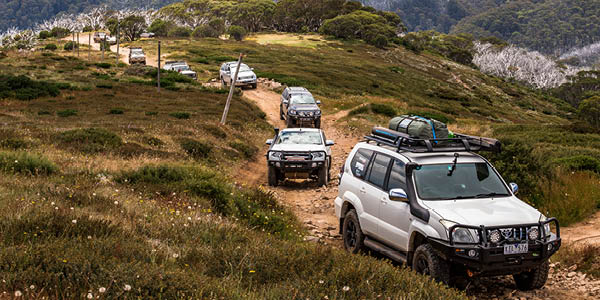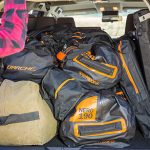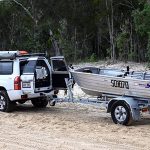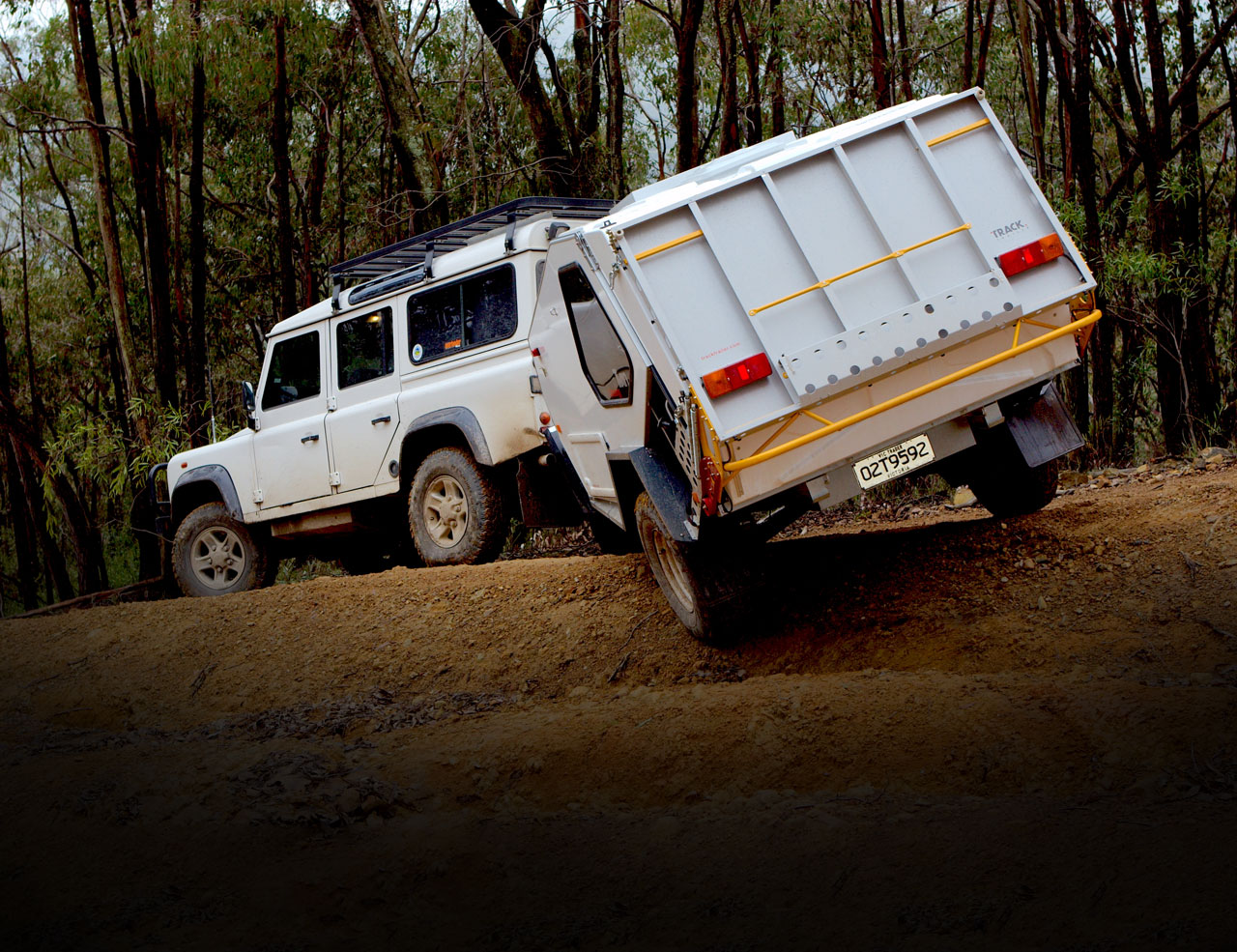Teaching Old Dogs New Tech
The number of 4WD vehicles being purchased or leased by tradies is growing every year and aftermarket companies are jumping on board and pimping the vehicles on the showroom floor. This means there are loads of off-road capable 4WDs being used solely as daily drivers instead of heading bush and crawling up some gnarly tracks.
Some mates decided it was time to learn a few things about driving in low range and they thought I might be the right bloke to educate and empower them to get off the bitumen more often. I accepted and decided to take them up to the Victorian High Country. I rang a buddy in Queensland who’s explored Oz as much as I have and convinced him to head home to Victoria for a few days and give me a hand.
When organising a meet and greet with a group of 4WDrivers, there are two places I highly recommend: The pub for a counter meal or a Bunnings carpark over a couple of snags. For this trip it was decided to congregate at the Mansfield Hotel and I was shocked when everyone arrived on time. Over parmas and steaks, the group gelled… and we were soon heading towards Buller before leaving the bitumen behind on Buttercup Road.
At Tomahawk Hut we met up with the final two vehicles before the education process began. The group consisted of the following vehicles and crew:
Andre – 2012 Ford Ranger XLT – graded Fraser Island;
Chris – 2013 Ford Ranger XLT – didn’t get stuck at Inskip Point;
Clair and Amanda – 2017 Ford Ranger XLT – smashed Skytrek in the Flinders and dabbled in the High Country, also completed a 4WD driving course;
Chris – GQ Patrol SWB ute – born in the HC; and
Neil – GQ Patrol SWB ute – raised in the HC after escaping from England.
The first lesson we dished out was about tyre pressures in the High Country. Generally, all the tracks contain the same ingredients – clay, rocks, wheel ruts and erosion mounds. Throw in the occasional river or creek crossing and you have it all. Dropping your tyre pressures will increase your footprint which in turn will provide better traction and reduce the risk of punctures due to the tyre rolling over the rocks instead of pushing into them. The same goes for a camper trailer and I advised Clair to drop his trailer tyres down to 20psi to start off with.
Number 3 Track was the first challenge with some good gradients, tight switchbacks, large erosion mounds and loose and shingly rocks. Low range was the suggestion for each of the newbies. Andre, Chris and Clair were given the opportunity to play with the rear eLockers and Hill Launch Assist in their Rangers on their way up onto the ridgeline and into our first camp.
Pushing to 1,500m, we debriefed and prepared dinner around the fire. An icy wind picked up as the sun dipped below the treeline and everyone soon retreated to the comfort of their swags. Day two saw the camp engulfed by the clouds. The gear was damp, with the sun straining to break through. It was eerie as we departed camp – heading to Razorback Hut for a look around. It was disgraceful to find toilet paper strewn at the back of the huts, especially as there are pit toilets in place. Some people have no clue.
By the time we reached the iconic Craigs Hut, the skies had begun to clear and we enjoyed brilliant views across to Mount Cobbler. This was the first visit for almost all the crew – so some time was spent reading the storyboards and snapping away on cameras.
The biggest challenge on the trip was up next: Clear Hills Track up to Mount Stirling. We dropped the camper trailer off at Monument Track before briefing the group on what to expect on the drive to Stirling. The object was to watch the line taken by the previous vehicle and follow (as closely as possible) the same line.
Clear Hills Track is very steep in places and chopped up badly by traffic and weather. Add some loose rocks and off-camber angles and some fun can be had. Clair and Amanda were following me. With only one short section causing any concern, an obvious line turned deceptive with no grip achievable on the dusty surface. It was better to drive the ‘harder’ line (that was in fact much easier).
It was Andre and then Chris who had a little bit of difficulty at the same spot. Andre’s Ranger is stock standard height and his rear bar hangs awfully low. The lack of flexibility tore a rear mudflap from its place and minor track building had to be completed for the Rangers to get up the step. Chris has a 2-inch lift in his Ranger but he had problems with traction.
Upon reaching the peak of Mount Stirling, the adrenaline was flowing strong as vehicles were inspected for pinstriping or bent side steps. It was here that we said goodbye to Chris, Chris and Neil who had to go back to work the next day. After the happy snaps were taken, and the pies put in the oven, the rest of us turned around and headed back down Clear Hills Track.
The descent can be just as difficult as the ascent, with the same angles reversed and many erosion mounds leaving drivers with no sight of the track. Hill Descent Control was put through its paces as Clair and Andre practised the skill of driving down a steep track.
We enjoyed a quick lunch before hitching up the camper again and tackling Monument Track. It was on this track that I coached Clair on how overriding the electric brakes of the camper would help reduce his downhill speeds. It was going well until he realised that there were issues with the hitch and tongue on his Ranger. The nut on the Treg Hitch was working itself loose, causing the hitch and receiver to jackknife. On a flat section of the track, we swapped the tongue and spring washer from my vehicle and provided a better fit for the Treg Hitch. We had no more problems after that.
A quick walk up to Bindaree Falls was enjoyed before taking the Bluff Link Track. Unfortunately the day was getting away and while I would have preferred the more picturesque and challenging 16 Mile Jeep Track, the boring link track was the quickest route to reach Bluff Track.
We passed a parked grader on the climb up towards Bluff Hut, with contractors busy carrying out track maintenance along the length of the route. The erosion mounds were the biggest I’ve seen, and no-one escaped scraping on one or two of them. The flies at Bluff Hut were minimal; strange really, but we didn’t stay long. Everyone was keen to get to camp after a long day of driving.
I knew of a spot just north of the hut that was right on the ridgeline, with jaw-dropping views from either side. When the other vehicles pulled into camp behind me, all I heard was ‘WOW’ on the UHF. We quickly set up and admired the views before hunkering down by the crackling fire with a hearty meal.
It was a stunning morning as everyone got stuck into some bacon and eggs before packing up camp. We left the camper trailer and followed the roadworks up to Lovicks Hut – meeting the excavator working hard on the track, just before Picture Point. We couldn’t proceed so we backtracked to Lovicks for a look and then stopped on one of the open plains and stretched our legs for a while. Once we hitched up the camper trailer again, we made our way down to Frys Hut via the Bluff Link Road and Brocks Road. A swim in the Howqua River was enjoyed before coals were prepared for the final night’s feast. Pork on the spit with roast vegies, corn and gravy constituted most of the menu; and Amanda cooked up some stewed apples picked from a tree next to Frys Hut.
As we sat around the fire that night, we reflected on the lessons learnt over the last few days. Driving slowly while using the vehicle traction aids was the biggest lesson; as well as how to tow a camper trailer in challenging conditions. Clear Hills Track was the obvious winner of ‘Best Track’ but ‘Best Camp’ couldn’t be agreed upon. As darkness fell and the fire settled, Andre pulled out his guitar and entertained us for a couple of hours… the perfect way to finish the night and the adventure.
Fact File
WHERE: Mount Stirling, with Mansfield the closest point for fuel and supplies.
WHEN TO GO: A lot of the tracks are seasonally closed from the Queen’s Birthday weekend in June until 1 November. Summer is a great time as it’s a bit cooler up high.
WHAT DO I NEED: A full tank of fuel, water to keep hydrated, food and some warm clothes. It can snow even in February in the High Country.
CAN I UPDATE SOCIAL MEDIA: Limited opportunities – up high great, down low bad.
WARNINGS: Keep an ear to the local radio for weather and bushfire updates.
TRACK RATINGS: In the dry, high clearance and traction control/low range are required. In the wet, some tracks are impassable or require lockers.
TOP TIP
Learn how to read a map so that you can determine how steep a track is by the distance between the contour lines.
Contacts and Info:
Parks Victoria
https://parkweb.vic.gov.au/safety/fire,-flood-and-other-closures
Vic Emergency
https://emergency.vic.gov.au/respond/










